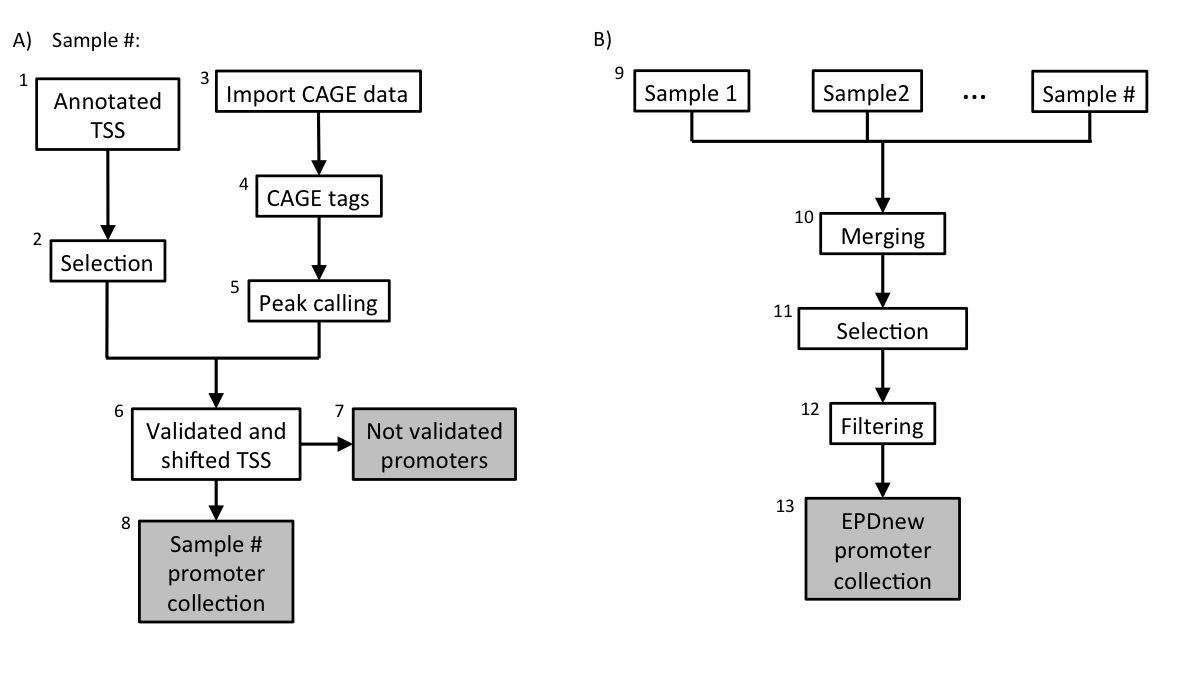TSS assembly pipeline for Zm_EPDnew_001
Introduction
This document provides a technical description of the transcription start site assembly pipeline that was used to generate EPDnew version 001 for Z. mays
Source Data
Promoter collection:
| Name | Genome Assembly | Promoters | Genes | PMID | Access data | ||
|---|---|---|---|---|---|---|---|
| Gramene Genes | Oct 2013 B73 RefGen_v3/zm3 | 35171 | 26651 | 26553803 | SOURCE | DOC | DATA |
Experimental data:
| Name | Type | Samples | Tags | PMID | Access data | ||
|---|---|---|---|---|---|---|---|
| Mejía-Guerra et al., 2015 | CAGE | 8 | 28,277,292 | 26628745 | SOURCE | DOC | DATA |
Assembly pipeline overview

|
Description of procedures and intermediate data files
1. Download annotated TSS
Data was downloaded from Gramene Mart the 01-06-2016. Transcripts have been filtered according to the following rules:- Transcripts of protein coding genes only
- Transcript lies on full chromosomes
- Transcripts have a non-empty description field
A total number of 35171 promoters were selected.
2. Gramene TSS collection
The Gramene TSS collection is stored as a tab-deliminated text file conforming to the SGA format under the name:-
zm_gramene_tss.sga
- NCBI/RefSeq chromosome id
- "TSS"
- position
- strand ("+" or "-")
- "1"
- gene stable ID
3. Import CAGE data
Data was imported from GEO as SRA file format. Raw sequence files were mapped to zm3 genome using Bowtie. The resulting BAM files were converted to SGA file format using ChIP-Convert.5. mRNA 5' tags peak calling
For each individual sample (8), peak calling for the merged file has been carried out using ChIP-Peak on-line tool with the following parameters:- Window width = 200
- Vicinity range = 200
- Peak refine = Y
- Count cutoff = 9999999
- Threshold = 5
6. TSS validation and shifting
Each sample in the collection (mRNA peaks and Gramene TSS) was then separately processed in a pipeline aiming at validating transcription start sites with mRNA peaks. A Gramene TSS was experimentally confirmed if an mRNA peak lied in a window of 500 bp around it. The validated TSS was then shifted to the nearest base with the higher tag density.7. UCSC not-validated TSS
The total number (summing up all samples) of non experimentally validated TSS was around 15000.8. Promoter collection for each sample
Each sample in the dataset was used to generate a separate promoter collection. Potentially, the same transcript could be validated by multiple samples and it could have different start sites in different samples. To avoid redundancy, the individual collections were used as input for an additional step in the analysis (Assembly pipeline part B).9. Merging collections and second TSS selection
The 8 sample-specific promoter collections were merged into a unique file and further analyzed. Transcripts validated by multiple samples could potentially have the TSS set on a broader region rather than a single position. To avoid such inconsistency, for each transcript we selected the position that was validated by the larger number of samples as the true TSS.Different TSSs that belong to the same gene were classified according to their global expression level. The primary TSSs of a gene (marked with an '_1' at the end of the ID) have always the highest expression level followed by all the other in decreasing order of expression (marked as '_2', '_3', etc.).
10. Filtering
Transcription Start Sites that mapped closed to other TSS that belonged to the same gene (500 bp window) were merged into a unique promoter following the same rule: the promoter that was validated by the higher number of samples was kept.10. Final EPDnew collection
The 17081 experimentally validated promoters were stored in the EPDnew database, which can be downloaded from our ftp site. Scientists are welcome to use our other tools ChIP-Seq (for correlation analysis) and SSA (for motif analysis around promoters) to analyze the EPDnew database.Last update October 2019